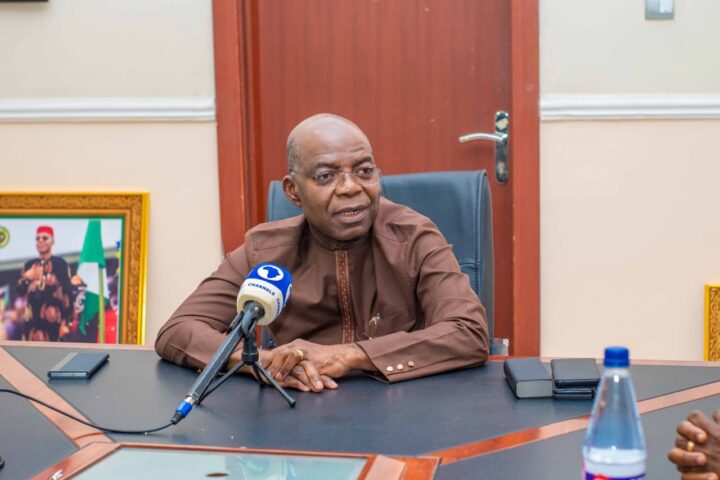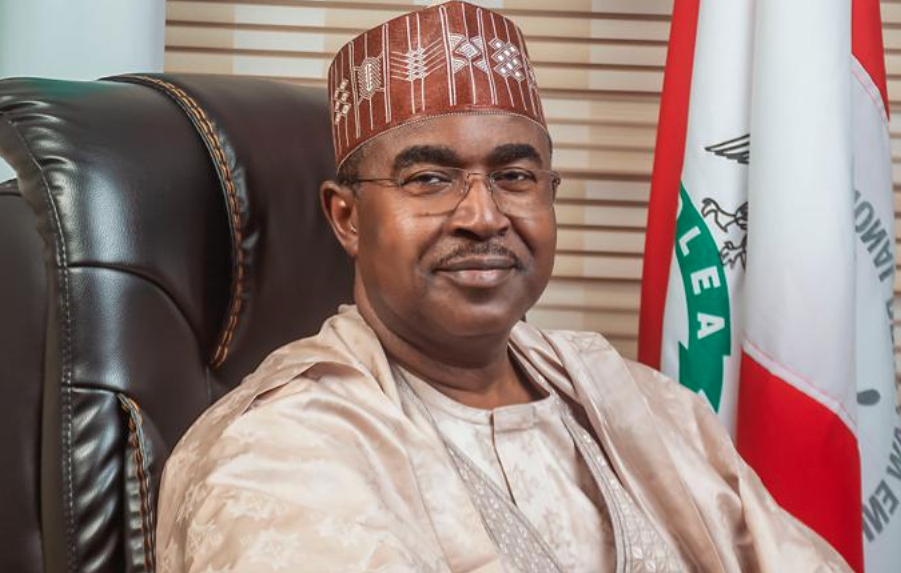On July 3, 2023, the Peoples Republic of China (PRC) imposed export controls on gallium and germanium, which are two rare minerals widely used in semiconductor production and other high technology goods. The requirement for export license by China, which is the world’s largest producer of both minerals, is a response to the export controls placed by the United States of America (USA) on the export of advanced artificial intelligence (AI) semiconductors and advanced computing technology to China, effective October 7, 2022, and most recently in December 2022. The geopolitical outcomes of this contest between two of the world’s largest economies, as well as unfolding events from the recent BRICS Summit of August 2023, however provides symbiotic opportunities for semiconductor and advanced technology production at Enyimba Economic City (EEC) Aba, with Alex Otti as Governor- if well harnessed.
What then is the underlying factor for the geopolitical tensions between the US and China?
The US views some of the technology developments in China as a threat to its national security and interests. The US argues that the leadership that Chinese companies such as Huawei have in 5G technology, and access to advanced semiconductors, has enabled China’s military constitute a threat to US security and interests, including in Taiwan. While China considers Taiwan as part of the PRC, the US does not necessarily act accordingly, thereby exacerbating tensions between both countries.
Firstly, some industry context of semiconductors, sometimes called chips, for better comprehension of its geopolitical impact. The global market size of semiconductors was $573 billion in 2022, and is projected to rise to $1.380 trillion in 2029. Some of its classifications include Application Specific Signal Processors (ASSP), Application-Specific Integrated Circuits (ASIC), Microprocessors (MPU) and Microcontroller (MCU). Semiconductors are the building blocks of modern digital devices such as smartphones, washing machines, TVs, refrigerators, automobiles and industrial equipment. They are used for networking & communications, advanced military equipment, data processing, industrial manufacturing and consumer electronics. The average modern car has between 1,400 – 1,500 semiconductor chips, and some cars have as much as 3,000 chips. While smartphones consume 50 percent of chips developed, automakers consume 15 percent of developed chips. 1.15 trillion semiconductor chips were shipped in 2021. Therefore, there is hardly any modern innovation or digital economy without semiconductors.
Advertisement
Taiwan is home to Taiwan Semiconductor Manufacturing Company Ltd (TSMC), the largest semiconductor company globally, which was founded in 1997, has market value of $582 billion and revenue of $72 billion. TSMC semiconductors are used by Apple Inc, the US tech company valued at $2.79 trillion, for the production of MacBook Air and iPhones. Other leading semiconductor manufacturing companies are Samsung, Intel (INTC), Qualcomm, SK Hynix Inc, Broadcom Corporation, Micron Technology, and Nvidia Corporation. Others include Applied Materials, Texas Instruments Inc, Toshiba, Maxim Integrated Products and NXP Semiconductors. Taiwan, Japan, South Korea, U.S. and the Netherlands are therefore the countries that lead in semiconductor manufacturing, which the US relies on for its economic, technological and military might.
The vulnerability of the leading semiconductor manufacturing countries to China’s military might, therefore explains the national security and interest vulnerabilities of the U.S., that led to the semiconductor related bans on China. The ban by the US through Department of Commerce’s Bureau of Industry and Security, first imposed in 2015, directly restricts China’s ability to obtain, develop, and manufacture advanced semiconductor technology. It applies not just to U.S.-made chips, but also to any chip produced using U.S.-origin technology, software, or equipment. The U.S.-origin based regulation meant that Japan and the Netherlands agreed at a January 27, 2023 meeting with the U.S., to impose advanced chip export restrictions on China, further expanding the geopolitical effects of chip manufacturing- but also opportunities for some countries.
The threat to U.S. economic, technological and military might occasioned by the vulnerability of advanced semiconductor manufacturing in Taiwan due to Chinese military activities, has led the US to strategically start channeling advanced technology investments towards other locations away from Taiwan and China, as a way of reducing its vulnerabilities. In addition to the U.S., the search for other locations that can provide the same comparative advantage as Taiwan, but without the geopolitical risks of Chinese military risks, provides a geopolitical opportunity for Nigeria, especially the Enyimba Economic City (EEC), for advanced semiconductor manufacturing.
Advertisement
The geopolitical discord between China and the U.S. is a long-running one, which translates to almost firm opportunities for countries outside the military sphere of U.S. geopolitical rivals. The long-running nature of this dispute is further evidenced by both the CHIPS Act, and the Chip 4 Alliance. ‘The CHIPS and Science Act’ of 2022, worth $280 billion, provides significant funding for tech companies. Companies that receive funding or support under the Act, are however prohibited from expanding semiconductor manufacturing in China, or any countries that pose a threat to US national security. The ‘Chip 4 Alliance’ is an alliance proposed by the U.S. government in March 2022, that aims to bring together three of the strongest semiconductor giants in Asia– Taiwan, Japan, and South Korea, to weaken China’s growing dominance not just in the semiconductor industry, but other areas of critical importance. The technology dominance of the 5G market globally by Chinese companies such as Huawei, influenced these US policy efforts, while Canada and the United Kingdom are some of the major countries that have placed bans on 5G operations by Chinese companies.
It is important to add that with the threats posed by a potentially nuclear armed North Korea supported by Russia and China, Japan and South Korea have also joined Taiwan in becoming geopolitical risks for the US, which further enhances the need and prospects for new and safer semiconductor manufacturing locations, such as EEC. Taiwan did not become a semiconductor hub by accident, but through a combination of affordable tech skills, conducive environment and capital, that were affordable. Such conditions are present in Aba, Abia state, where EEC is located.
What then is the Enyimba Economic City, and how can it serve as a viable alternative and safe geopolitical location for the manufacturing of advanced semiconductors?
The Enyimba Economic City (EEC) is a 9.464 hectares Special Economic Zone (SEZ) under the Project MINE (Made-in-Nigeria for Exports) of the Nigerian Industrial Revolution Plan (NIRP) of 2014, as championed by the Federal Ministry of Industry, Trade and Investment (FMITI). It is located in Aba, Abia state, and provides immediate access to a captive market of 200 million in Nigeria, 450 million in West Africa and 1.2 billion in the Africa Continental Free Trade Area (AfCFTA).
Advertisement
The EEC comprises sections for work, residence, learning and leisure. It is designed as a vibrant integrated city with growth sectors in industrial activities, logistics, lifestyle residential, entertainment, medical, knowledge, tech hub and aviation. It has Free Trade Zone (FTZ) status, with complete holiday from all federal, state and local government taxes, rates, and levies, duty free importation of capital goods, machinery, components, spare parts, raw materials and consumable items in the zone. The city also allows for 100 percent foreign ownership of investments, 100 percent repatriation of capital, profits and dividends, a waiver of all imports and export licenses and a waiver on all expatriate quotas for companies operating in the zones, amongst other incentives. Approvals of the FMITI were largely secured under Dr. Okechukwu Enelamah, as Minister of FMITI.
Strategically located on the Aba-Port Harcourt expressway, near existing Onne and Port Harcourt seaports, with good proximity to the proposed Akwa Ibom Deep Sea Port, it will have its independent inland port and airport, and is also located along key rail lines of Port Harcourt – Maiduguri, giving it a major connection to northern parts of Nigeria. Independent power supply will be provided by Geometric Power, through dedicated power plants. Advanced technology supply is aviation based, and EEC is 40 minutes from both Owerri Sam Mbakwe Cargo Airport and Port Harcourt International Airport.
For financing of this fully conceptualised US$1.4 billion project, which will commence in the last quarter of 2023 and is expected to create over 625,000 jobs over the next 10 years, $430 million was secured at the African Development Bank (AfDB) led Africa Investment Forum in 2019. This will enable onboarding of the first phase of 1,499 hectares that include the first industrial park where semiconductor plants can be built, as well as for logistics, wholesale market and an inland port. There is a signed term sheet with African Export-Import Bank (Afreximbank) for $201.7 million, out of which they are underwriting $150 million. Both Afreximbank and FirstBank of Nigeria PLC are supporting the debt finance, which with its rigorous due diligence, had the final term sheet signed on March 3, 2023. The city had in 2019, won $25,000 funding and partnership at the Charter Cities Institute, after defeating projects from Australia and Russia.
There is also an agreement with the International Finance Corporation (IFC), to market the project to the global market. EEC is 100 percent private sector-driven with an explicit shareholding structure of 50 billion shares. 50 percent of the shares are subscribed while the outstanding 50 percent would be publicly offered through an Initial Public Offer (IPO), to hold within the first five years of the commencement of construction.
Advertisement
In economic planning, emphasis is placed on the advantages that a location can provide. Aba, where EEC is located, is known as ‘Japan of Africa’. And for good reason. A couple of decades back, technology development in Aba rivalled Taiwan, which today leads in semiconductor manufacturing. The technological and economic development of Aba was however contained, due to a combination of political and economic factors such as military and governance deficit, but which have gradually been overcome. The technological prowess of the city has however been on the rebound in the past decade, hence the investment decision for EEC. The south-eastern neighbouring Nnewi town, which also shares the ‘Japan of Africa’ appellation with Aba, is home to Innoson Vehicle Manufacturing (IVM), and other leading tech-based companies in the continent. IVM started vehicle manufacturing with scores of expatriate staff, but today, all its leading staff are Nigerian. This is evidence of the technological skill set in the South East of Nigeria, to produce, adapt, innovative and enhance the best of global technology, albeit, at more affordable cost.
From the geopolitical perspective, Aba where the EEC is located, has demography that is pro-western by tradition. There is hardly any extended family in south eastern Nigeria without an American, European, Canadian or Western hemisphere citizen. There is therefore no need to ‘win hearts and minds’, as hearts and mind are by default, in same place as the U.S. You don’t sing to the choir. Though not intentional, they are by default through family, education, and commercial reasons largely pro-western, and located way beyond the military proximity of U.S. geopolitical rivals. It is therefore a safe place for the expansion of modern western technology, as the U.S. searches for alternate locations with affordable production costs, skilled personnel and culturally familiar people. The EEC is a safe business bet.
Advertisement
KPMG has completed the study for Phase 2 Medical City of EEC, alongside partnership progress with The Hospital Company (THC), a consortium of 50 top medical doctors of Nigeria origin in the U.S. and Europe. In sum, the EEC will promote the integration of Nigerian businesses into regional and global value chains, including the global semiconductor value chain- with Governor Otti’s strategic input.
Who then is Governor Otti, and how does he fit into the plan of having EEC host advanced semiconductor and technology manufacturing plants?
Advertisement
Assuming office on May 29, 2023 as the 10th governor of Abia state in south eastern Nigeria, Alex Obioma Otti is an economics graduate, with a working career in the banking sector that has seen him head a commercial bank, with international operational presence in other countries. The impressive performance he posted as bank chief executive, is a demonstration of his capacity to manage and attract domestic and international financial investments. He is also endowed with the geopolitical knowledge, international financial capacity, industry experience and skill set required to pull off significant investment decisions, such as attracting advanced semiconductor and other high-tech manufacturing to the EEC.
The opportunities provided for semiconductor manufacturing at EEC are further supported by U.S. geopolitical moves towards increased investment with Africa. This influenced the December 13-15, 2022 second ‘U.S.-Africa Leaders Summit’. The consensus among experts is that the summit, which took place after the last one in 2014, was designed by the U.S. to counter the growing economic influence of China and Russia in Africa. This can also be glimpsed from the “U.S. Strategy Towards Sub-Saharan Africa” of August 2022. From 2007 to 2017, U.S. trade with Africa declined by 54 percent, while China’s trade with Africa grew by 220 percent. In 2020, China had business deals with Africa worth $735 billion with 623 Chinese businesses, while the U.S. had deals worth $22 billion from 80 countries. These are the geopolitical opportunities that Governor Otti can harness, in ensuring that EEC becomes an integral part of the global semiconductor and advanced technology manufacturing value chain.
Advertisement
The U.S. led the other G7 countries to launch the Partnership for Global Infrastructure and Investment (PGII) in 2022, as a counter to the Belt and Road Initiative (BRI) of China. The US$1 trillion BRI, launched in 2013, has been a foreign economic initiative that China has used to expand its influence across the world, and the US$600 billion PGII response by the U.S. positions the EEC, with leadership direction from Alex Otti, as potential beneficiaries.
From a manufacturing perspective, some may argue that South Africa may be a friendlier investment climate within the continent. Contemporary geopolitics however gives Nigeria and EEC the edge, as South Africa is a leading member of the BRICS countries, which includes Brazil, Russia, India, China and South Africa. China and Russia are of course, known geopolitical rivals of the US. The recent BRICS Summit hosted by South Africa on August 22, 2023 where statements against the US dollar and other commitments that hamper US interests were made, positions Nigeria and EEC as a preferred alternative. South Africa’s BRICS membership therefore makes it less attractive to strategic and geopolitical US investments.
The announcement at the recent BRICS summit on August 24, 2023, of new members of the bloc that does not include Nigeria, provides the U.S. an opportunity to demonstrate its geopolitical commitment towards Africa, by encouraging the location of a part of the global advanced semiconductor manufacturing in Africa’s largest economy, at a place that also economically justifies such investment. The average semiconductor plant cost about $20 billion, and Governor Otti is well positioned to negotiate with financiers, industry leaders and geopolitical stakeholders for part of the chip supply chain to be located at EEC.
President Biden of the U.S. met with South Korean President and Japanese Prime Minister on August 18, 2023 at Camp David, to discuss threats in Asia-Pacific region. This first-of-its-kind trilateral summit shows long-term plans and geopolitical realignments, that also provides opportunities. Japan and South Korea, which are both high income countries, have put aside longstanding political differences to harness opportunities from geopolitical changes. Nigeria and Otti should be doing the same.
In addition to the diaspora that can support, there are some individuals of Abia origin, who can potentially support the successful attainment of this objective. They include Prof. Ndubuisi Ekekwe, founder of First Atlantic Semiconductors & Microelectronics Ltd (FASMICRO), and Dr. Okechukwu Enelamah, the former Minister of Industry, Trade and Investment under whose tenure as minister, EEC obtained its approvals. Enelamah, a medical doctor cum investment buff, is founder of African Capital Alliance (ACA), one of the leading investment management firms on the continent, with portfolio over the billion dollars mark. Still on sustainable provision of technology and research skill base, there is the nearby Federal University of Science and Technology Owerri, and Gregory University Uturu, founded by Prof. Gregory Ibe. Prof. Ibe is also founder of ‘Skill G’, a company that has demonstrated competence in science, technology, innovation and development of high skilled human capital, over the years. These are part of the human capital that Governor Otti can work with to successfully attract advanced semiconductor and high-tech manufacturing to EEC.
The domestic business case for semiconductor manufacturing is supported by the proximity of EEC to Nnewi, where vehicle manufacturing and other medium to high technology manufacturing takes place. With semiconductor manufacturing, EEC potentially becomes a hub and part of the value chain for electric vehicles, mobile phones and other consumer electronics. This domestic value chain component will enable Nigeria attain some of its national technology policies, such as the ‘National Policy for the Promotion of Indigenous Content in the Nigerian Telecommunications Sector (NPPIC) of 2021, for the development of indigenous content in Nigeria’s telecommunications sector, which led to the establishment of Nigeria Office for Developing the Indigenous Telecom Sector (NODITS). It also potentially supports the attainment of Presidential Order 005 on ‘Planning and Execution of Projects, Promotion of Nigerian Content in Contracts and Science, Engineering and Technology’ and Presidential Executive Order 003 on ‘Support for Local Content Procurements by Ministries, Departments and Agencies of the Federal Government of Nigeria’.
‘Enyimba’ means elephant, and speaks to both the city’s previous tech and economic exploits, but also untapped prospects. Therefore, plans and aspirations for the city should be of elephant sized. Whether as ‘onye Ngwa or Aro’, or a combination of both, footprints of both suggest a governor with inherent capacity to reestablish tech parity between Aba and Taiwan, as was the case in the 1970s and 1980s. Otti can provide the required leadership, strategic fit and financial skill to ensure that the geopolitical opportunities, human and financial capital within and around the Enyimba Economic City, are harnessed to make the city a part of the $600 billion global semiconductor industry. This could also ensure the pride of place for a Renascent Africa, as expounded by Nnamdi Azikiwe (Zik of Africa). Will Otti rise to the challenge?
Dr. Uwanaka writes from African University of Science and Technology, Abuja. [email protected]
Views expressed by contributors are strictly personal and not of TheCable.
Add a comment







